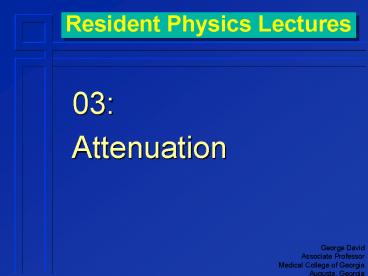Resident Physics Lectures - PowerPoint PPT Presentation
1 / 23
Title:
Resident Physics Lectures
Description:
03: Attenuation Attenuation Reduction in amplitude & intensity as sound travels through medium Causes absorption sound energy converted to heat dominant influence in ... – PowerPoint PPT presentation
Number of Views:25
Avg rating:3.0/5.0
Title: Resident Physics Lectures
1
Resident Physics Lectures
- 03
- Attenuation
2
Attenuation
- Reduction in amplitude intensity as sound
travels through medium - Causes
- absorption
- sound energy converted to heat
- dominant influence in soft tissue
- reflection
- scattering
3
Absorption
- Units
- decibels (dB)
- dB indicates signal gain
- indicates signal gets larger
- - indicates signal gets smaller
- ultrasound absorption is always negative dB
- sound always loses intensity
- negative sometimes implied
- dB indicates fraction of intensity lost
4
Logarithm Review
- x log10(y) means10 to what power y
?or10x y
5
Logarithms Review
- log 1 0
- log 10 1
- log 100 2
- log 10n n
- log (1/10) 10-1 -1
- log (1/100) 10-2 -2
- log (1/1000) 10-3 -3
6
Gain Decibels
Power In
Tissue (attenuation)
Power Out
- decibel definition
- dB 10 X log10 power out / power in
Power Ratio Power Out / Power In
dB 10 X log10 power ratio
7
Gain Decibels
Power In
Tissue (attenuation)
Power Out
Power Ratio Power Out / Power In
- Power Ratio gt 1
- Amplifier
- Power Out gt Power In
- Log Power ratio gt0
- Power Ratio lt 1
- Absorber / Attenuator
- Power Out lt Power In
- Log Power ratio lt0
dB 10 X log10 power ratio
8
Power Ratio
Power Ratio Power Out / Power In
dB 10 X log10 power ratio
Decibel calculation Power ratio dB 1
0 10 10
100 20 1/100 -20
10 n n X 10 2
3
- logarithms
- log 1 0
- log 10 1
- log 100 2
- log 10n n
- log (1/10) 10-1 -1
- log (1/100) 10-2 -2
- log (1/1000) 10-3 -3
9
dB Attenuation
- dB / 10 indicates of powers of ten attenuation
- Every increase of 10 dB indicates another factor
of 10 attenuation
10
dB Try Again
10 dB 1 factor of 10 or 10 you morons
60 dB 6 factors of 10 or 1,000,000, nyuk, nyuk,
nyuk
20 dB 2 factors of 10 or 10 X 10 or 100
10 dB 1 power of 10 10 20 dB 2 powers of 10
100 60 dB 6 powers of 10 1,000,000
11
Attenuation Frequency
- Attenuation affected by
- medium
- frequency
- As frequency increases, so does attenuation
- bass sound carries farther than treble
- high frequency poorer penetration
12
Attenuation In Soft Tissue Rule of Thumb
- 0.5 dB / cm attenuation for each MHz frequency
- cm refers to distance of sound travel
- other texts may say 1 dB / cm depth / MHz
- 1 cm depth equivalent to 2 cm sound travel
13
Rule of Thumb0.5 dB/cm/MHz
- To calculate attenuation (dB) simply multiply
rule of thumb by round trip distance by
frequency - 5 MHz sound 10 cm sound travel
- attenuation 0.5 dB/cm/MHz X 10 cm X 5 MHz 25
dB - 3.5 MHz sound 4 cm sound travel
- attenuation 0.5 dB/cm/MHz X 4 cm X 3.5 MHz 7
dB
14
Attenuation Coefficient
- Attenuation Coefficient 0.5
Freq. (dB/cm) (dB/cm/MHz) (MHz) - indicates fraction of beamintensity lost per
unit distanceof sound traval
15
Attenuation Coefficient
- Attenuation Coefficient 0.5
Freq. (dB/cm) (dB/cm/MHz) (MHz)
Frequency (MHz) Attenuation Coefficient (dB/cm)
1 0.5
2 1.0
5 2.5
10 5
16
Attenuation CoefficientComments
- Attenuation Coefficient 0.5
Freq. (dB/cm) (dB/cm/MHz) (MHz) - Longer path results in increased attenuation
- Higher frequency results in increased attenuation
coefficient - Higher attenuation coefficient results in more
attenuation
17
dB vs. Intensity Ratio
dB attenuation 10 X log10 intensity ratio
Fraction attenuated 1 - intensity ratio
- dB Intensity Fraction
- atten. Ratio atten.
- 1 .79 .21
- 2 .63 .37
- 3 .50 .50
- 4 .40 .60
- 5 .32 .68
- 10 .1 .90
- 20 .01 .99
- 30 .001 .999
18
Soft Tissue Attenuation Calculation
- Attenuation Attenuation Coefficient X Path
Length
Freq. Atten Coef. Atten(dB). Int. Red.
Atten(dB) Int. Red. dB /
cm 1 cm 1 cm 10 cm 10 cm
2.0 1.0 1 21 10 90 3.5 1.8 1.8 34 18 98
5.0 2.5 2.5 44 25 99.7 7.5 3.8 3.8 58 38 9
9.98 10.0 5.0 5.0 68 50 99.999
19
Attenuation
- Why dB?
- dBs can be added together
- Rule of thumb doesnt always work
- Attenuation higher in lung bone than in soft
tissue - Attenuation in lung and bone not proportional to
frequency
Class during lecture on attenuation
20
Attenuation Coefficients
0.5 dB/cm/MHz is soft tissue average assumed by
scanner
Tissue Attenuation Coefficient
(dB/cm/MHz)
- Fat 0.6
- Brain 0.6
- Liver 0.5
- Kidney 0.9
- Muscle 1.0
- Heart 1.1
21
Half Intensity Depth
- Decreases with increasing frequency
HID 3 dB / Attenuation Coefficient
HID 3 dB / Freq (MHz) 2
Frequency Atten Coef. HID (MHz) dB/cm cm -------
-----------------------------------------------
1 0.5 6.0 2 1.0 3.0 5 2.5 1.2 10 5.0 0.
6
22
Attenuation
- half intensity depth (HID)
- depth where intensity 50 of original
- corresponds to 3dB attenuation
180
150
HID
100
66
39
23
Practical Implications of Attenuation
- limits maximum imaging depth
- higher frequencies result in
- increased attenuation
- decreased imaging depth
- improved axial resolution

